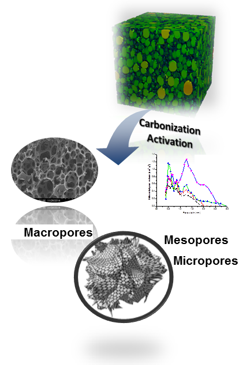Researchers produced nitrogen-doped, cellular-structure-activated carbon

Researchers have developed monolithic, nitrogen-containing, microporous, cellular-activated carbon from phenol-urea-formaldehyde (PUF) organic foam for CO2 and H2 adsorption. The macroporosity corresponded to the connected network of cells with diameters ranging from 100 to 600 μm, and the pinholes in the cell walls had diameters ranging from 1 to 2 μm. The micro/mesoporosity is located at the inner surface of the cells.
Cellular-activated carbon, a new type of activated carbon, is based on carbon foams, the inner surfaces of which are activated physically by CO2 to generate an available surface made up of micro/mesopores. The carbon foams are enriched with macropores that are connected to the cell walls. After activation, the cellular-activated carbon produces a network of micro and mesopores at the surface of the macropores; therefore, this new bimodal cellular activated carbon can be used just like classic activated carbon as an adsorbent, for catalyst support, energy storage and biological material in various industries.
ACs are normally in the form of grains, or are granular with surface areas mainly controlled by their inner microporosity (pore size less than 2 nm), and mesoporosity (pore size ranging from 2 to 50 nm). The mesoporosity also plays a role in the pathways for reactants flowing through the carbon grains. Using this carbon foam as a precursor provides pathways for the macropores, so the new cellular-activated carbon exhibits monolithic shape and high adsorption kinetics due to the size of the bigger pores.
More information: Weigang Zhao et al, Preparation and Characterization of Nitrogen-Containing Cellular Activated Carbon for COand HAdsorption, Nano (2016).
Provided by World Scientific Publishing




















